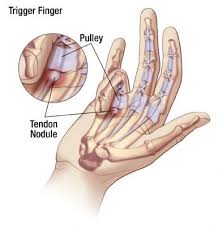
Do you have a trigger? It creeps up on you slowly. With time, it suddenly locks, and then straightens with a snap – like a trigger being pulled and released. What is a “trigger finger”? It is a condition that affects the tendons and the pulleysin your fingers or your thumb.
Tendons are tissues that connect muscles to bone. In the finger, the pulleys are a series of rings that form a tunnel through which the tendons glide, much like the guides on a fishing rod through which the line (or tendon) must pass. The tendons and the tunnel have a lining that allows easy gliding of the tendon through the pulley.(1)
With overuse,the flexor tendon can become irritated as it slides through the pulley. It may become inflamed and swollen, and you will initially feel soreness at the base of your finger or thumb. With time, nodules may form, causing the opening of the pulley to become smaller. This creates a painful clicking or snapping when you bend or straighten the finger. Sometimes the finger becomes momentarily stuck, and in more severe cases, you must gently straighten it with your other hand.
Symptoms tend to be worse after inactivity such as when you wake up in the morning. Trigger finger may be caused by repeated movement or forceful use of the finger(s) or thumb. You may be at greater risk if you have certain health problems such as diabetes or rheumatoid arthritis. It tends to occur more commonly with women.
Once diagnosed, your doctor may recommend hand therapy. A splint would be fitted to rest your finger and worn for 3-6 weeks. You would be instructed in specific gentle range of motion activities to reduce stiffness and changing activities to reduce swelling. Along with therapy, treatment may include use of anti-inflammatory medication and a possible corticosteroid injection. Your finger may recover within a few weeks.
This is not a dangerous condition, but you may decide to have surgery if your finger remains stuck in a bent position. You would then return to hand therapy to help you regain mobility, reduce swelling, and minimize post-op scar tissue for maximum return in functional use of your hand. If you have any questions or concerns, please feel free to consult with our hand therapists at Proactive.
(1) Trigger Finger, ASSH.org

